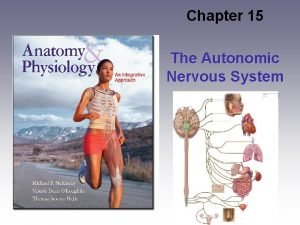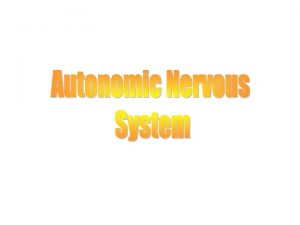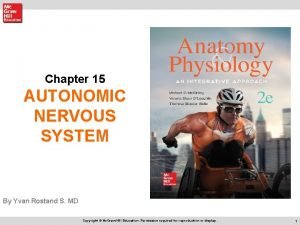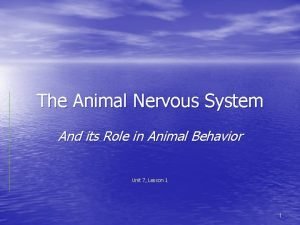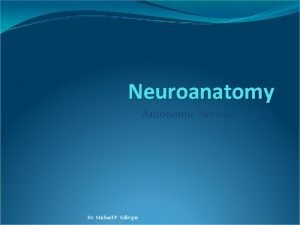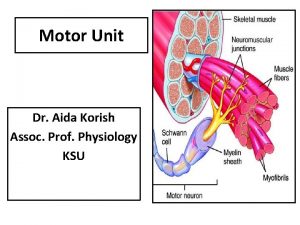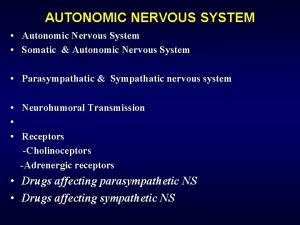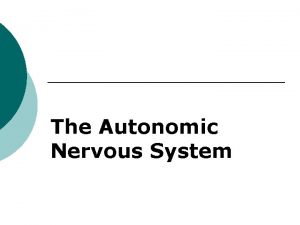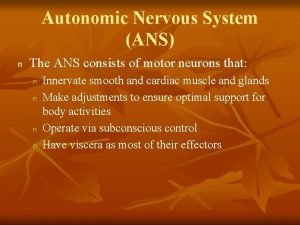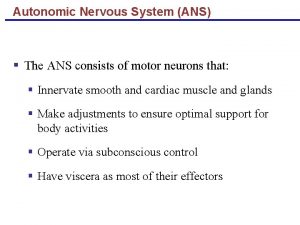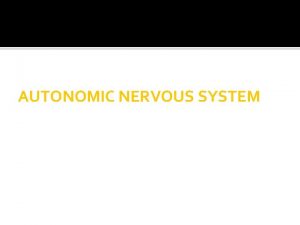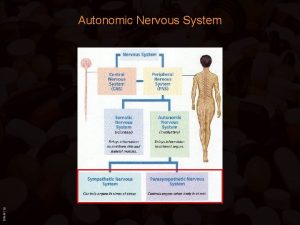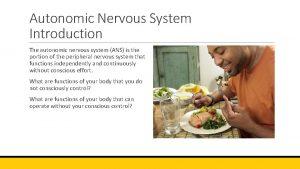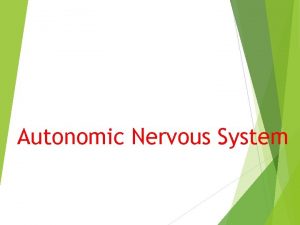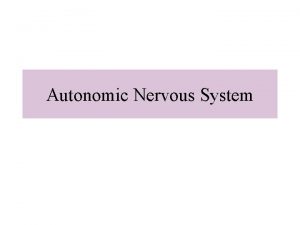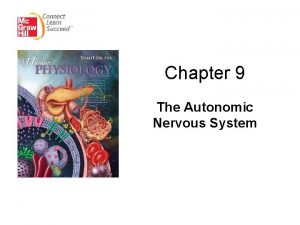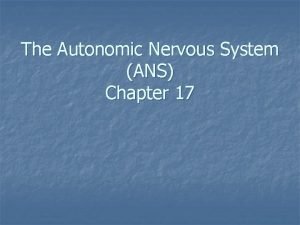Autonomic Nervous System ANS ANS consists of motor



















- Slides: 19

Autonomic Nervous System (ANS) • ANS consists of motor neurons that – Innervate smooth and cardiac muscle, and glands – Make adjustments to ensure optimal support for body activities – Operate via subconscious control • Also called involuntary nervous system or general visceral motor system © 2013 Pearson Education, Inc.

Figure 14. 1 Place of the ANS in the structural organization of the nervous system. Central nervous system (CNS) Peripheral nervous system (PNS) Sensory (afferent) division © 2013 Pearson Education, Inc. Motor (efferent) division Somatic nervous system Autonomic nervous system (ANS) Sympathetic division Parasympathetic division

Somatic Versus Autonomic Nervous Systems • Both have motor fibers • Differ in – Effectors – Efferent pathways and ganglia – Target organ responses to neurotransmitters © 2013 Pearson Education, Inc.

Effectors • Somatic nervous system – Skeletal muscles • ANS – Cardiac muscle – Smooth muscle – Glands © 2013 Pearson Education, Inc.

Efferent Pathways and Ganglia • Somatic nervous system – Cell body in CNS; thick, myelinated, group A fiber extends in spinal or cranial nerve to skeletal muscle • ANS pathway uses two-neuron chain 1. Preganglionic neuron (in CNS) has a thin, lightly myelinated preganglionic axon. 2. Postganglionic (ganglionic) neuron in autonomic ganglion outside CNS has nonmyelinated postganglionic axon that extends to effector organ © 2013 Pearson Education, Inc.

Neurotransmitter Effects • Somatic nervous system – All somatic motor neurons release acetylcholine (ACh) – Effects always stimulatory • ANS – Preganglionic fibers release ACh – Postganglionic fibers release norepinephrine or ACh at effectors – Effect is either stimulatory or inhibitory, depending on type of receptors © 2013 Pearson Education, Inc.

Figure 14. 2 Comparison of motor neurons in the somatic and autonomic nervous systems. Cell bodies in central nervous system Neurotransmitter at effector Peripheral nervous system Effector organs Effect SOMATIC NERVOUS SYSTEM Single neuron from CNS to effector organs ACh + Stimulatory Heavily myelinated axon Skeletal muscle Two-neuron chain from CNS to effector organs NE SYMPATHETIC Lightly myelinated preganglionic axons Nonmyelinated postganglionic axon Ganglion ACh Acetylcholine (ACh) © 2013 Pearson Education, Inc. Blood vessel ACh Lightly myelinated preganglionic axon Norepinephrine (NE) +– Epinephrine and norepinephrine Adrenal medulla PARASYMPATHETIC AUTONOMIC NERVOUS SYSTEM ACh Ganglion Nonmyelinated postganglionic axon Smooth muscle (e. g. , in gut), glands, cardiac muscle Stimulatory or inhibitory, depending on neurotransmitter and receptors on effector organs

Overlap of Somatic and Autonomic Function • Most spinal and many cranial nerves contain both somatic and autonomic fibers • Adaptations usually involve both skeletal muscles and visceral organs © 2013 Pearson Education, Inc.

Divisions of the ANS • Sympathetic division • Parasympathetic division • Dual innervation – ~ All visceral organs served by both divisions, but cause opposite effects • Dynamic antagonism between two divisions maintains homeostasis © 2013 Pearson Education, Inc.

Role of the Parasympathetic Division • Promotes maintenance activities and conserves body energy – Directs digestion, diuresis, defecation • As in person relaxing and reading after a meal – Blood pressure, heart rate, and respiratory rates are low – Gastrointestinal tract activity high – Pupils constricted; lenses accommodated for close vision © 2013 Pearson Education, Inc.

Role of the Sympathetic Division • Mobilizes body during activity; "fight-orflight" system • Exercise, excitement, emergency, embarrassment – Increased heart rate; dry mouth; cold, sweaty skin; dilated pupils © 2013 Pearson Education, Inc.

Role of the Sympathetic Division • During vigorous physical activity – Shunts blood to skeletal muscles and heart – Dilates bronchioles – Causes liver to release glucose © 2013 Pearson Education, Inc.

Figure 14. 3 The subdivisions of the ANS. Parasympathetic Eye Sympathetic Brain stem Salivary glands Skin* Cranial Sympathetic ganglia Heart Eye Salivary glands Cervical Lungs T 1 Heart Stomach Thoracic Pancreas Liver and gallbladder Pancreas L 1 Liver and gallbladder Adrenal gland Lumbar Bladder © 2013 Pearson Education, Inc. Genitals Bladder Sacral Genitals

Interactions of the Autonomic Divisions • Most visceral organs have dual innervation • Dynamic antagonism allows for precise control of visceral activity – Sympathetic division increases heart and respiratory rates, and inhibits digestion and elimination – Parasympathetic division decreases heart and respiratory rates, and allows for digestion and discarding of wastes © 2013 Pearson Education, Inc.

Table 14. 4 Effects of the Parasympathetic and Sympathetic Divisions on Various Organs (1 of 2) © 2013 Pearson Education, Inc.

Table 14. 4 Effects of the Parasympathetic and Sympathetic Divisions on Various Organs (2 of 2) © 2013 Pearson Education, Inc.

Sympathetic Tone • Sympathetic division controls blood pressure, even at rest • Vascular system ~ entirely innervated by sympathetic fibers • Sympathetic tone (vasomotor tone) – Keeps blood vessels in continual state of partial constriction © 2013 Pearson Education, Inc.

Sympathetic Tone • Sympathetic fibers fire more rapidly to constrict blood vessels and cause blood pressure to rise • Sympathetic fibers fire less rapidly to prompt vessels to dilate to decrease blood pressure • Alpha-blocker drugs interfere with vasomotor fibers – Used to treat hypertension © 2013 Pearson Education, Inc.

Parasympathetic Tone • Parasympathetic division normally dominates heart, smooth muscle of digestive and urinary tract organs, activate most glands except for adrenal and sweat glands – Slows the heart – Dictates normal activity levels of digestive and urinary tracts • The sympathetic division can override these effects during times of stress • Drugs that block parasympathetic responses increase heart rate and cause fecal and urinary retention © 2013 Pearson Education, Inc.
 Autonomic nervous system consists of
Autonomic nervous system consists of Alpha 1 receptors
Alpha 1 receptors Skeletal muscle autonomic nervous system
Skeletal muscle autonomic nervous system Somatic and autonomic nervous system
Somatic and autonomic nervous system Autonomic
Autonomic Autonomic nervous system
Autonomic nervous system The autonomic nervous system controls
The autonomic nervous system controls Adrenal gland sympathetic nervous system
Adrenal gland sympathetic nervous system Autonomic dysreflexia
Autonomic dysreflexia Somatic and autonomic nervous system
Somatic and autonomic nervous system Motor neuron
Motor neuron Peripheral nervous system consists of
Peripheral nervous system consists of Peripheral nervous system consists of
Peripheral nervous system consists of Neural circuits the organization of neuronal pools
Neural circuits the organization of neuronal pools Fundamentals of the nervous system and nervous tissue
Fundamentals of the nervous system and nervous tissue Nerve cell process
Nerve cell process Autonomic motor neurons regulate visceral activities by
Autonomic motor neurons regulate visceral activities by Autonomic nerveous system
Autonomic nerveous system Motor unit consists of
Motor unit consists of Nervous system and digestive system
Nervous system and digestive system





